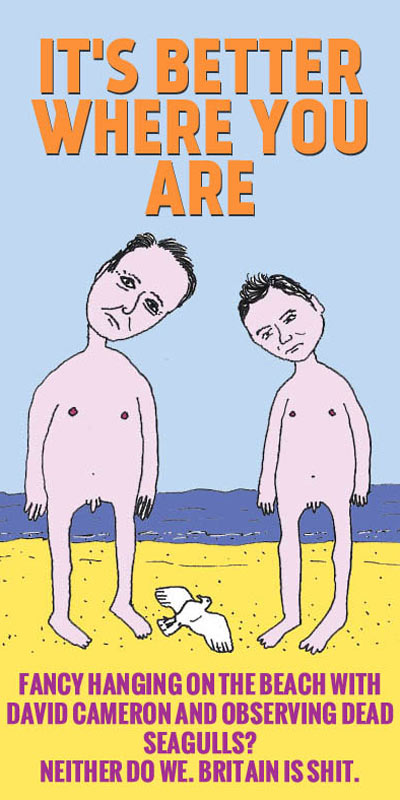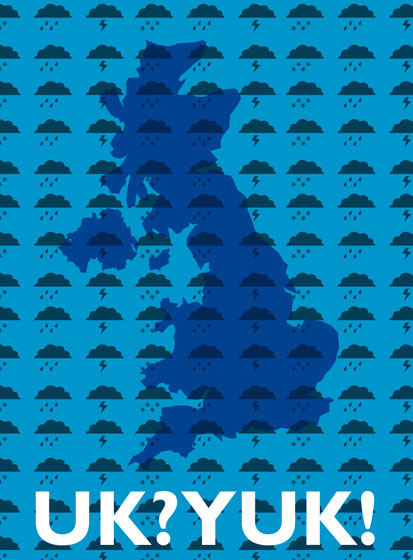Category Archives: Uncategorized
“Britain: it’s rubbish. Don’t come here. Move to Italy or Germany instead, the weather’s much nicer and the transport infrastructure isn’t on the verge of collapse”…
Over the weekend The Guardian ran a story that the British Government was reportedly considering a negative ad campaign to discourage would-be immigrants. Yesterday, James Walsh, a columnist for The Guardian invited readers to respond to the ludicrous idea with their own tongue-in-cheek suggestions. Check it out! Below are some of the contributions submitted by the public.




Check out the Invisible Borders Film!
“Invisible Borders Trans-African Photographic Initiative is an art-led initiative, founded in Nigeria in 2009 by passionate Nigerian artists – mostly photographers – with a drive and urge to effect change in the society. It was registered in 2011 under the Cooperate Affairs Commission (CAC) of Nigeria as Invisible Borders Trans-African Photographers Organisation. The vision of the initiative is to become a symbol of networking and trans-border associations within the arts and photography in Africa, but also to become a stepping-stone platform for young immerging talents in the continent in such a way that it creates a breeding ground for young artist to be thinking beyond borders at the beginning stage of their creative quest.
The mission of the Initiative is to tell Africa’s stories, by Africans, through photography and inspiring artistic interventions; to encourage exposure of upcoming African photographers towards art and photography as practiced in other parts of the continent.; to establish a platform that encourages and embraces trans- African artistic relationships within the continent, and to contribute towards the socio-political discourse shaping Africa of the 21st Century.
Their goal is to constantly spread and share knowledge and information, cutting across the demarcating lines of classes and proficiency in literacy, thereby expanding the art public to include more of the local audience and the “layman”.
Their activities aim to cut through the local, national and international, and to create points of interactions between these levels, hence the name Invisible Borders. The main activity /project of the Initiative since its foundation has been The Invisible Borders Trans-African Road Trip Project, a project where about a dozen artists/photographers collectively take road trip across Africa to explore and participate in various photographic events, festival and exhibitions while engaging on a daily basis with the environment and the people encountered. The emphasis is primarily on the collective journey of the participating artists who, during their momentary stops in capital cities, create photographic, video and textual works that often reflect their individual approach to engaging with local artists, art practitioners and the inhabitants. They also collaborate intensively with colleagues from each of the countries involved.
Participants of Invisible Borders are dedicated to creating works, which portray the dynamism, richness as well as contradictions of the various modes of existence of the African people. In doing this, they reject a simplified notion of Africa nor a tidy definition of it, but instead hopes to create an archive of works which “complicates” the depiction of contemporary Africa, one which sees the continent as work-in-progress, rather than a foregone conclusion.
We can therefore see the Invisible Borders Road trip as a workshop of artistic creation and a performative social intervention all rolled into one. Moreover it offers that unique experience of “learning in motion” and discovering oneself through interactions with diverse encounters by constantly altering one’s own reality through constant movement. Check out their film!
Check out the Student Voices Project!
Blog Story: Sharing, Surviving and Academic Instinct
In the early stages of constructing this blog, when we were still brainstorming on what direction to take and how, I was asked by CRS Coordinator, Michelle Millard if I would be willing to meet with the CERIS Knowledge Mobilisation Officer, Raymond Hyma to hear what he might have to say. This was an offer I couldn’t decline as Hyma is an expert in strategic communications, and if anyone could help me it was certainly him.
I knew very little about KM, but what I did know was that KM’s approach to knowledge was different and more accessible than traditional academic approaches. Rather, in my view, KM seemed less fixated on epistemological questions about the nature of knowledge, and more focused on impact and transmission which are both key issues that are often ignored in academia.
At any rate, I knew that this meeting would be important if I wanted to deepen my understanding of KM. And (unfortunately!) I also knew that it would be expected that I arrive with some thoughtful ideas of my own…
And so, towards these ends, I wrote a rather (excruciatingly) long text philosophizing on the value and meaning of KM, which also described my grand vision for this blog. Within an hour of emailing this text to Hyma, my inbox showed that he had replied. Not expecting such a speedy response I ( as well as my ego) took it as a sign that he liked my ideas.
As you will see, it wasn’t so simple!
The first line of his email read: “You have introduced a lot of material re: KM”, and this was followed by “not exactly sure what might be useful to discuss tomorrow… are you developing a strategy?”
Of course, I had no intention of developing a strategy, and, besides, how could he not be sure of what to discuss? “What more did he want?” I would say in my head while groaning inwardly and thinking: “sure, my vision was a little abstract, but isn’t that expected when deep academic philosophizing is involved?”
Frankly, akin to most recalcitrant academics, I felt like I was being snubbed. Of course, Hyma was not disregarding my philosophizing or blue-skies mode of thought, he was simply calling attention to the predictable inchoate style in which we graduate students and scholars write.
Let me keep it real; my grand-blue-sky-overt-the-top-inchoate-thinking lacked grounding—it was probably boring (as hell), as well.
My so called ‟vision” was a classic example of how, among other things, we scholars struggle to be effective communicators. I, for instance, was guilty of failing to meet at least two basic KM principles: (a) don’t be too cryptic and (b) get to the bloody point!!
Using myself as example, this anecdote serves to show that while scholars are considered experts in the business of knowledge production, they are, conversely, also experts in complicating their knowledge and making it inaccessible.
I wonder sometimes whether this is not instinctual on our part – rooted in a sub-conscious of self-preservation. What I mean by this is that professionally speaking, scholars rely heavily on their inaccessibility. Scholars and researchers make their living from producing knowledge that is not only difficult to grasp (and which is too often irrelevant) but that’s also removed from public scrutiny. In this regard, we must ask ourselves, what good is publicly funded knowledge if it’s accessible only to a small group of experts who may or may not care about its impact? For instance, what good is it researching immigrant and refugee experiences if that research will not be used by the organizations who serve newcomers? Who privileges from inaccessible knowledge ?
In her recent Al Jazeera opinion piece “Academic Paywalls Mean Publish and Perish” Sarah Kendzior insists that journals and academic databases like JSTOR are among those benefiting from academia’s insularity. She claims that, for example, JSTOR not only charges exorbitant prices to universities in the form of subscriptions, but that they also make it very expensive for any member of the public who also want access to these resources (Kendizor 2012).
In her opinion, charging the public makes no sense because less than 1% of JSTOR’s profits come from individual article sales. She writes, “[t]he high price is designed to maintain the barrier between academia and the outside world”.
For Kendizor, the underlying problem is not the dichotomy between public and private because many, she argues, fall into a grey zone based on institutional affiliation and personal wealth. In her opinion, the real problem is the “private theft of public culture”. This makes academic publishing a strategic enterprise which is less about open and accessible knowledge, and more about controlling knowledge and manipulating where and how the knowledge fountain flows.
As an example she notes the low acceptance rates (sometimes lower than 5 per cent) at some of the top journals, as a reason for why it is seen as prestigious to publish in such journals.
While, sometimes for academics the challenge has to do with getting one’s work out there (preferably via/in prestigious journals), the reverse also applies. That is, in academia you also don’t want your work to be overly accessible especially early on in your career. As Kendzior puts it, academics’ ability to remain employed often relies on their ability to limit and regulate the circulation of their work, and as such “the ability to prohibit scholarship is considered more meaningful than the ability to produce it”.
In short, academics that want to see their work have a real impact have got some serious thoughtful weighing to do. It means not only being critical about our own taken for granted scholarly practices (as Hyma kindly called my attention to), but it also means challenging some of the very principles that underscore academic scholarship and its increasingly neoliberal project. What’s certain is that we cannot do the latter without stepping out of our nesty comfort zones, something that is perhaps easier for the up-and-coming than for academia’s established vets. On the other hand, younger scholars and researchers, particularly those seeking tenure must resist temptation – i.e., the lure of limiting and regulating the circulation of their work as a means to jump-starting their career.
On this final note I’m reminded of one of Plato’s famous quotes, where, fittingly, he once declared: courage is a kind of salvation.
Welcome!
Welcome note
Welcome to our blog! Finally, after lots of talking we’re up! We are not the most experienced bloggers (but you probably sense this already), nevertheless, we are eager to share lots of information with you! Feel free to help us by posting your feedback, or even emailing us at knowledgeinmigration@gmail.com. Don’t worry about being too critical; we love a hard critic. We would also love to receive any links, blogs, articles etc, that you think may be of interest to us and our subscribers. Thanking you in advance!
The site is obviously still under construction, there’s a lot more here that we would like to do – but for now, what counts is that we have the bones – the rest will follow shortly.
Welcome!
This is the Knowledge Mobilization microsite of the Refugee Research Network.
What is Knowledge Mobilization (KM) and why is it important?
KM draws linkages between research, policy, and practice. It seeks to bridge the gap between what we know and what is being done. Below you will find resources that provide background to KM and links to various organizations and people that have either an explicit KM mandate or are doing interesting work related to KM.
Knowledge mobilization (KM) is a contested topic. The resources below provide working terms, definitions and conceptual frameworks within knowledge mobilization.
- Terms & Definitions – This OISE-RSPE resources provides an instrumental overview of helpful KT terms and definitions.
- Conceptual Frameworks – This OISE-RSPE page includes a diversity of conceptual KM related frameworks collected from various sources exploring the relationships between research, policy and practice.

